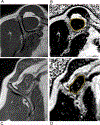Association of Patient Self-Reported Shoulder Scores to Quantitative and Semiquantitative MRI Measures of Rotator Cuff Intramuscular Fatty Infiltration: A Pilot Study
- PMID: 31509429
- PMCID: PMC7372701
- DOI: 10.2214/AJR.19.21218
Association of Patient Self-Reported Shoulder Scores to Quantitative and Semiquantitative MRI Measures of Rotator Cuff Intramuscular Fatty Infiltration: A Pilot Study
Abstract
OBJECTIVE. The purpose of this study was to determine the relationship of supraspinatus fat fraction and Goutallier grade to the American Shoulder and Elbow Surgeons (ASES) score in cohorts of older adults with painful full-thickness supraspinatus tendon (SST) tear and control subjects. SUBJECTS AND METHODS. Seventeen control subjects and 15 study participants with painful full-thickness SST tear were prospectively recruited (mean age ± SD, 63.0 ± 10.1 years and 62.6 ± 9.0 years, respectively). Study participants received shoulder MRI and completed ASES questionnaires at one time. Goutallier grade was assessed on T1-weighted MRI. Fat fraction was measured on 6-point Dixon MRI. Body mass index (BMI) was determined. Descriptive, correlation, reliability, and regression analyses were performed. RESULTS. The control and painful full-thickness SST tear cohorts differed in mean supraspinatus fat fraction (3.3% ± 1.4% and 7.3 ± 5.9%, respectively; p = 0.024) and Goutallier grade (0.4 ± 0.5 and 0.9 ± 0.7, respectively; p = 0.022). Fat fraction (p = 0.014) and Goutallier grade (p = 0.017) showed a significant inverse association with ASES score only in the SST tear cohort. The association of BMI to ASES score was significant only in the control group (p = 0.036). The correlation between BMI and fat fraction were different for the two groups (control cohort, r = 0.676 and p = 0.003; SST tear cohort, r = 0.124 and p = 0.687). Fat fraction showed strong interobserver reliability (intraclass correlation coefficient, 0.903); Goutallier grade showed poor interobserver reliability (κ = 0.178). CONCLUSION. The association of ASES score and supraspinatus fat fraction or Goutallier grade differs between patients with painful full-thickness SST tear and control subjects without symptoms. Although fat fraction shows strong reliability, Goutallier grade should be regarded cautiously because of suboptimal reproducibility. Our results also suggest that painful full-thickness SST tear alters the correlation between supraspinatus fat fraction and BMI as compared with control subjects.
Keywords: MRI; intramuscular fatty infiltration; quantitative; rotator cuff; shoulder.
Figures




Similar articles
-
Correlation of Quantitative Versus Semiquantitative Measures of Supraspinatus Intramuscular Fatty Infiltration to Shoulder Range of Motion and Strength: A Pilot Study.Curr Probl Diagn Radiol. 2021 Sep-Oct;50(5):629-636. doi: 10.1067/j.cpradiol.2020.06.007. Epub 2020 Jun 26. Curr Probl Diagn Radiol. 2021. PMID: 32654835 Free PMC article.
-
Reliability of supraspinatus intramuscular fatty infiltration estimates on T1-weighted MRI in potential candidates for rotator cuff repair surgery: full-thickness tear versus high-grade partial-thickness tear.Skeletal Radiol. 2021 Nov;50(11):2233-2243. doi: 10.1007/s00256-021-03805-9. Epub 2021 May 6. Skeletal Radiol. 2021. PMID: 33959799 Free PMC article.
-
Supraspinatus fatty infiltration on MRI among older adults receiving physical therapy as initial management for clinically suspected rotator cuff tear: A pilot study.J Clin Imaging Sci. 2022 Dec 22;12:66. doi: 10.25259/JCIS_138_2022. eCollection 2022. J Clin Imaging Sci. 2022. PMID: 36601603 Free PMC article.
-
Efficacy of Imaging Modalities Assessing Fatty Infiltration in Rotator Cuff Tears.JBJS Rev. 2019 Apr;7(4):e3. doi: 10.2106/JBJS.RVW.18.00042. JBJS Rev. 2019. PMID: 30969180
-
Muscle fat infiltration: a narrative review of the magnetic resonance (MR)-based evaluation methods and their clinical applications.Quant Imaging Med Surg. 2024 Dec 5;14(12):9563-9588. doi: 10.21037/qims-24-177. Epub 2024 Aug 20. Quant Imaging Med Surg. 2024. PMID: 39698678 Free PMC article. Review.
Cited by
-
Estimating 3D supraspinatus intramuscular fatty infiltration in older adults: a pilot study.Acta Radiol. 2023 May;64(5):1880-1885. doi: 10.1177/02841851221139597. Epub 2022 Nov 24. Acta Radiol. 2023. PMID: 36423232 Free PMC article.
-
Supraspinatus Fatty Infiltration Correlation with Handgrip Strength, Shoulder Strength, and Validated Patient-Reported Outcome Measures in Patients with Rotator Cuff Tears.Kans J Med. 2022 May 17;15(2):155-159. doi: 10.17161/kjm.vol15.16343. eCollection 2022. Kans J Med. 2022. PMID: 35646246 Free PMC article.
-
Correlation of Quantitative Versus Semiquantitative Measures of Supraspinatus Intramuscular Fatty Infiltration to Shoulder Range of Motion and Strength: A Pilot Study.Curr Probl Diagn Radiol. 2021 Sep-Oct;50(5):629-636. doi: 10.1067/j.cpradiol.2020.06.007. Epub 2020 Jun 26. Curr Probl Diagn Radiol. 2021. PMID: 32654835 Free PMC article.
-
Reliability of supraspinatus intramuscular fatty infiltration estimates on T1-weighted MRI in potential candidates for rotator cuff repair surgery: full-thickness tear versus high-grade partial-thickness tear.Skeletal Radiol. 2021 Nov;50(11):2233-2243. doi: 10.1007/s00256-021-03805-9. Epub 2021 May 6. Skeletal Radiol. 2021. PMID: 33959799 Free PMC article.
-
A visual marker for early atrophy of the supraspinatus muscle on conventional MRI: introduction of the blackbird sign.Eur Radiol. 2025 Jan;35(1):313-322. doi: 10.1007/s00330-024-10946-7. Epub 2024 Jul 11. Eur Radiol. 2025. PMID: 38992107 Free PMC article.
References
-
- Yamamoto A, Takagishi K, Osawa T, et al. Prevalence and risk factors of a rotator cuff tear in the general population. J Shoulder Elbow Surg 2010; 19:116–120 - PubMed
-
- Melis B, Nemoz C, Walch G. Muscle fatty infiltration in rotator cuff tears: descriptive analysis of 1688 cases. Orthop Traumatol Surg Res 2009; 95:319–324 - PubMed
-
- McElvany MD, McGoldrick E, Gee AO, Neradilek MB, Matsen FA 3rd. Rotator cuff repair: published evidence on factors associated with repair integrity and clinical outcome. Am J Sports Med 2015; 43:491–500 - PubMed
Publication types
MeSH terms
Grants and funding
LinkOut - more resources
Full Text Sources
Medical

